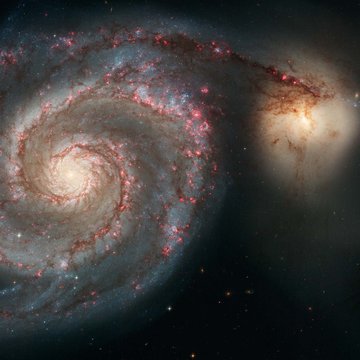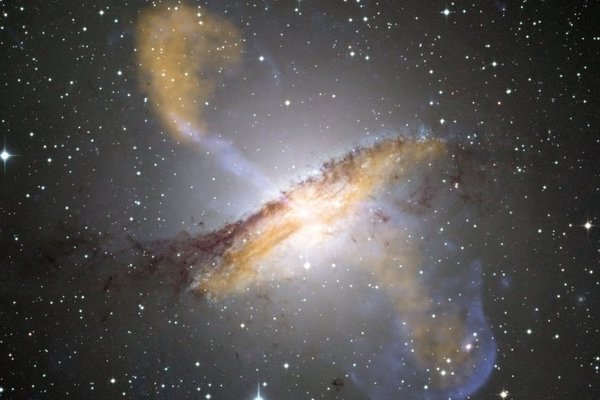Galaxies and Quasars

The "Whirlpool Galaxy" M51 with its spiral arms and gleaming gas clouds, 30 million light years away from us.
Credit: NASA, ESA, S. Beckwith (STScI) and the Hubble Heritage Team (STScI/AURA)Silke Kuba-Lehmann
skuba@aip.de
Galaxies are systems like our Milky Way, consisting of billions of stars, cool and hot interstellar gas, dust clouds, black holes, as well as (probably) large quantities of Dark Matter into which the visible galaxies are embedded. Galaxies show a bewildering multitude of appearances: With or without spiral arms, disc-like or spherical, regular or irregular, rich or poor in gas and dust, isolated or surrounded by many other galaxies.
In the research section "Galaxies and Quasars" we investigate this diversity and the conditions leading to the formation and evolution of certain properties. Our speciality is the spectroscopic analysis of galaxies, in particular using the technique of Integral Field Spectroscopy. Below you can read more about us, our work, and our results.
Spatially Resolved Spectroscopic Diagnostics of Galaxies

The central region of the spiral galaxy NGC 300, observed with the MUSE spectrograph.
Credit: Martin Roth (innoFSPEC, AIP), Peter Weilbacher (AIP)We study the structure and composition of galaxies by analysing their spectra at various locations across their spatial extents. Our galaxies are typically too distant to see individual stars, but still close enough to well resolve their main structures. We measure kinematic signatures to detect ordered motion such as rotation, infall, or outflow, but also random motion patterns. In combination with dynamical models we draw inferences about the formation histories of different types of galaxies, and we use stellar population models to reconstruct star formation histories. We are interested in the interplay of interstellar gas in galaxies, observable through characteristic emission lines, and the stars embedded and surrounding these gas clouds. We are involved in several of the largest integral field spectroscopic surveys such as ATLAS3D, CALIFA, and SAMI.
[more]Supermassive Black Holes and Active Galactic Nuclei

The active galaxy NGC 5128 with its collimated outflow (grey: starlight; orange: radio, blue: X-rays)
Credit: ESO/WFI (Optical); MPIfR/ESO/APEX/A.Weiss et al. (Submillimetre); NASA/CXC/CfA/R.Kraft et al. (X-ray)While probably all galaxies above a certain mass contain Supermassive Black Holes (SMBHs) in their centres, the number of SMBHs actually detected through their gravitational pull is still quite small. We are engaged in searches for more SMBHs, especially in galaxy types that so far tend to be underrepresented. We also study black holes in their much more violent form of Active Galactic Nuclei (AGN), over the full range of the connected phenomena: from low-luminosity AGN which can be revealed only by careful analysis of the central regions of galaxies to luminous quasars, objects that completely outshine their host galaxies and discharge copious amounts of hard radiation into the cosmos. Of particular interest to us is the question how strongly AGN can influence and modify their host galaxies, through their radiation or by driving large-scale outflows.
[more]Spectroscopic Surveys of Faint Galaxies in Deep Fields
Blind spectroscopic surveys using panoramic integral field spectrographs are a radically new way to probe galaxy evolution across redshifts and cosmic times. With the MUSE instrument we are exploring selected regions previously observed to great depth with the Hubble Space Telescope and other important space missions. In these so-called Deep Fields we have obtained spectra and identified large numbers of extremely faint galaxies, many of them well below all previous detection thresholds. We are also involved in HETDEX, a conceptually similar blind survey, but aiming at building a sample of much brighter objects over a much larger area.
[more]Observations of the Circumgalactic Medium

Clouds of cosmic hydrogen surrounding distant galaxies. The image is synthesised from observations with the MUSE instrument on the ESO-VLT and with the Hubble Space Telescope.
Credit: ESO/L. WisotzkiGalaxies are surrounded by large amounts of gas, the so-called circumgalactic medium (CGM). Because of its low densities the CGM is extremely hard to observe. We recently succeeded to reveal, for the first time in individual objects, the presence of ubiquitous extended Lyman-α emitting envelopes around normal star-forming galaxies at high redshifts. We investigate the properties and dynamics of these gaseous haloes and explore mechanisms responsible for the Lyman-α emission. We have also started to extend our CGM studies towards other (weaker) lines and lower redshifts.
[more]Group Members
Scientific Publications
Involvement in Institute Projects
We are involved in several large AIP institutional project. Here you find an overview and links to these projects.
[more]